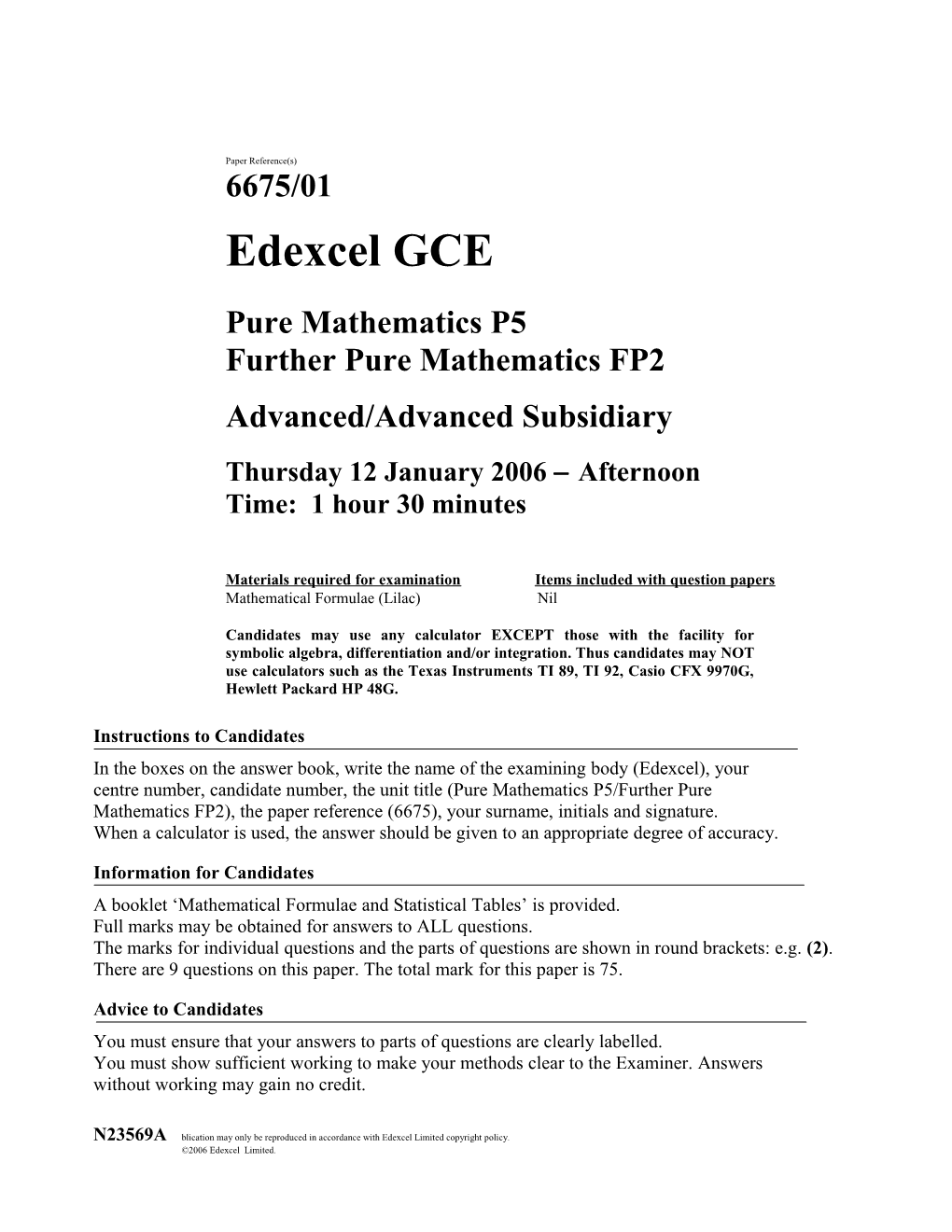Paper Reference(s)
6675/01
Edexcel GCE
Pure Mathematics P5
Further Pure Mathematics FP2
Advanced/Advanced Subsidiary
Thursday 12 January 2006 Afternoon
Time: 1 hour 30 minutes
Materials required for examination Items included with question papers
Mathematical Formulae (Lilac) Nil
Candidates may use any calculator EXCEPT those with the facility for symbolic algebra, differentiation and/or integration. Thus candidates may NOT use calculators such as the Texas Instruments TI 89, TI 92, Casio CFX 9970G, Hewlett Packard HP 48G.
Instructions to Candidates
In the boxes on the answer book, write the name of the examining body (Edexcel), your centre number, candidate number, the unit title (Pure Mathematics P5/Further Pure Mathematics FP2), the paper reference (6675), your surname, initials and signature.
When a calculator is used, the answer should be given to an appropriate degree of accuracy.
Information for Candidates
A booklet ‘Mathematical Formulae and Statistical Tables’ is provided.
Full marks may be obtained for answers to ALL questions.
The marks for individual questions and the parts of questions are shown in round brackets: e.g. (2).
There are 9 questions on this paper. The total mark for this paper is 75.
Advice to Candidates
You must ensure that your answers to parts of questions are clearly labelled.
You must show sufficient working to make your methods clear to the Examiner. Answers
without working may gain no credit.
N23569Ablication may only be reproduced in accordance with Edexcel Limited copyright policy.
©2006 Edexcel Limited.
1.Evaluate dx, giving your answer as an exact logarithm.
(5)
2.The hyperbola H has equation – = 1.
Find
(a)the value of the eccentricity of H,
(2)
(b)the distance between the foci of H.
(2)
The ellipse E has equation + = 1.
(c)Sketch H and E on the same diagram, showing the coordinates of the points where each curve crosses the axes.
(3)
3. A curve is defined by
x = t + sin t, y = 1 – cos t,
where t is a parameter.
Find the length of the curve from t = 0 to t = , giving your answer in surd form.
(7)
4.(a)Using the definition of cosh x in terms of exponentials, prove that
4 cosh3 x – 3 cosh x = cosh 3x.
(3)
(b)Hence, or otherwise, solve the equation
cosh 3x = 5 cosh x,
giving your answer as natural logarithms.
(4)
5.The curve C has equation
y = ln (sec x), x < .
Taking s = 0 at the point where x = , find an equation for C in the form s = f(), where s and are intrinsic coordinates.
(8)
6.The curve C has equation y = cosh3 x.
(a)Show that the radius of curvature of C may be written as
= ,
where c = cosh x.
(6)
(b)Find, to 2 significant figures, the radius of curvature of C at the point where x = ln 2.
(3)
7.Given that
In =
(a)show that In = In – 1 , n 1.
(6)
Given that ,
(b)use the result in part (a) to find the exact value of .
(3)
8.(a)Show that artanh = ln (1 + 2).
(3)
(b)Given that y = artanh (sin x), show that = sec x.
(2)
(c)Find the exact value of .
(5)
9.The parabola C has equation y2 = 4ax, where a is a constant.
(a)Show that an equation for the normal to C at the point P(ap2, 2ap) is
y + px = 2ap + ap3.
(4)
The normals to C at the points P(ap2, 2ap) and Q(aq2, 2aq), p q, meet at the point R.
(b)Find, in terms of a, p and q, the coordinates of R.
(5)
The points P and Q vary such that pq = 3.
(c)Find, in the form y2 = f(x), an equation of the locus of R.
(4)
TOTAL FOR PAPER: 75 MARKS
END
N23569A1Turn over
